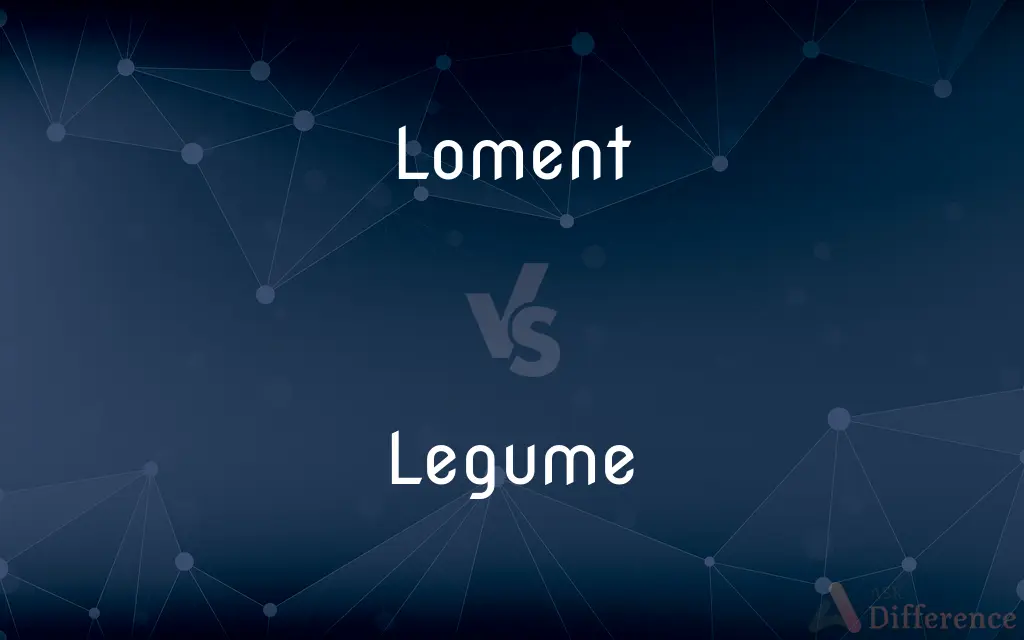Loment vs. Legume — What's the Difference?
By Fiza Rafique & Maham Liaqat — Updated on March 29, 2024
A loment is a type of legume fruit that breaks into segments, while a legume is a plant family or its fruit or seed.

Difference Between Loment and Legume
Table of Contents
ADVERTISEMENT
Key Differences
A loment is a specialized type of dry fruit that is characteristic of certain plants in the legume family. The term "legume" has multiple meanings: it can refer to a family of plants (Fabaceae or Leguminosae), the fruit or seed of these plants, or the edible seeds of certain species within this family.
Unlike typical legume fruits, which are pods that split open along two seams to release seeds, loments are segmented into several pieces. Legumes are distinguished by their fruit, commonly known as a pod, which typically splits open on two sides to release the seeds within.
Each segment of loment contains one or more seeds and breaks away at maturity, allowing for seed dispersal. This family of plants includes a wide variety of species, ranging from agricultural crops like beans and peas, to forage plants like clovers and alfalfa, to trees such as acacias and redbuds.
This feature distinguishes loments from other legume fruits by their unique form of dehiscence, or seed release mechanism, which is adapted to their specific dispersal strategies. Legumes are important in agriculture and ecology for their ability to fix nitrogen, enriching the soil where they grow.
Comparison Chart
Definition
A segmented type of legume fruit.
A plant family or its fruit or seed.
ADVERTISEMENT
Type
Fruit type
Plant family/category
Seed Dispersal
Breaks into segments for dispersal.
Pod splits open to release seeds.
Example Plants
Desmodium, Hedysarum.
Beans, peas, clovers, acacias.
Ecological Role
Adapted for specific dispersal strategies.
Nitrogen fixation, soil enrichment.
Compare with Definitions
Loment
Found within the legume family, but not all legumes produce loments.
Not all plants in the legume family produce loments; it's a feature of specific genera.
Legume
A plant family known for its pod-like fruits, also refers to the fruits/seeds themselves.
Legumes like peas and beans are staple foods in many diets around the world.
Loment
Designed to break into pieces, each carrying a seed.
The loment disperses its seeds by breaking into segments upon maturation.
Legume
Rich in protein, fiber, and micronutrients.
Legume seeds are a vital source of protein, especially in vegetarian diets.
Loment
Segmented, often with constrictions between seeds.
The loment's segments are clearly visible, indicating where it will break apart.
Legume
Play a critical role in nitrogen cycling and soil health.
Legumes enrich the soil by fixing atmospheric nitrogen, benefiting other plants in the ecosystem.
Loment
Facilitates seed dispersal by mechanical means.
When the loment segments fall to the ground, each can potentially grow into a new plant.
Legume
Used for food, fodder, and soil improvement through nitrogen fixation.
Legume crops are essential for their nutritional value and role in sustainable agriculture.
Loment
A segmented fruit typical of certain legume plants.
The loment from the Desmodium plant breaks into one-seed segments.
Legume
Includes a wide range of plants from herbaceous to woody species.
The legume family encompasses a broad diversity, from clover to acacia trees.
Loment
A loment (or lomentum) is a type of indehiscent legume fruit that breaks apart at constrictions occurring between segments, so that each segment contains one seed. It is a type of schizocarp.Tick trefoil (Desmodium) and sweet vetch (Hedysarum) are two genera that exhibit this fruit type, which is found particularly in the tribe Hedysareae of the family Fabaceae.
Legume
A legume () is a plant in the family Fabaceae (or Leguminosae), or the fruit or seed of such a plant. When used as a dry grain, the seed is also called a pulse.
Loment
A dry fruit of certain leguminous plants, such as the tick trefoil, having constrictions between the seeds and separating at maturity into one-seeded segments.
Legume
A plant of the pea family.
Loment
(botany) A type of modified legume that breaks apart at constrictions occurring between the segments of the seeds.
Legume
A pod of such a plant, which splits into two valves with the seeds attached to one edge of the valves.
Loment
An elongated pod, consisting, like the legume, of two valves, but divided transversely into small cells, each containing a single seed.
Legume
Such a pod or seed used as food. Peas, beans, and lentils are legumes.
Loment
Pods constricted between seeds and breaking apart when ripe into one-seed segments
Legume
(botany) The fruit or seed of leguminous plants (as peas or beans) used for food.
Legume
(botany) Any of a large family (Fabaceae, syn. Leguminosae) of dicotyledonous herbs, shrubs, and trees having fruits that are legumes or loments, bearing nodules on the roots that contain nitrogen-fixing bacteria, and including important food and forage plants (as peas, beans, or clovers).
Legume
(botany) A pod dehiscent into two pieces or valves, and having the seed attached at one suture, as that of the pea.
Legume
A pod dehiscent into two pieces or valves, and having the seed attached at one suture, as that of the pea.
Legume
The fruit of leguminous plants, as peas, beans, lupines; pulse.
Legume
An erect or climbing bean or pea plant of the family Leguminosae
Legume
The fruit or seed of any of various bean or pea plants consisting of a two-valved case that splits along both sides when ripe and having the seeds attached to one edge of the valves
Legume
The seedpod of a leguminous plant (such as peas or beans or lentils)
Common Curiosities
What is a loment?
A loment is a type of legume fruit that is segmented and breaks into pieces, each containing one or more seeds.
Why are legumes important in agriculture?
Legumes are crucial in agriculture for their nitrogen-fixing ability, which improves soil fertility, and for their nutritional value.
Can a legume be a tree?
Yes, some legumes are trees, such as acacias, which also produce pod-like fruits.
Are all legumes edible?
Not all legumes are edible; some are grown for other purposes, such as soil improvement or as ornamentals.
How are legumes beneficial to the environment?
Legumes benefit the environment by fixing nitrogen in the soil, which reduces the need for synthetic fertilizers.
How does a loment differ from a regular legume pod?
A loment is segmented and breaks into pieces for seed dispersal, unlike regular legume pods that split open along seams.
How do loments disperse their seeds?
Loments disperse their seeds by breaking into segments upon maturity, which then can be spread by various means.
What is the ecological role of a loment?
The ecological role of a loment is to facilitate seed dispersal through its unique segmented structure.
What defines a legume?
A legume can refer to a family of plants known for their pod-like fruits that open to release seeds, or to the fruits/seeds themselves.
Is a peanut considered a legume or a nut?
A peanut is considered a legume because it grows underground and belongs to the legume family, despite its common name.
What makes legumes a good food source?
Legumes are a good food source due to their high protein, fiber, and essential nutrients content.
Do all legumes fix nitrogen?
Most legumes have the ability to fix nitrogen in symbiosis with bacteria, but the efficiency can vary among species.
Can legumes improve soil without being planted as a crop?
Yes, wild legumes or those used as cover crops can improve soil health through nitrogen fixation without being harvested.
Are there legumes that do not produce pods?
All members of the legume family produce some form of pod, though the size, shape, and characteristics like being a loment can vary.
What is the significance of loments in seed dispersal?
Loments enhance seed dispersal efficiency by breaking into segments, which can spread seeds over a wider area.
Share Your Discovery

Previous Comparison
Biscuit vs. Roll
Next Comparison
Hyena vs. JackalAuthor Spotlight
Written by
Fiza RafiqueFiza Rafique is a skilled content writer at AskDifference.com, where she meticulously refines and enhances written pieces. Drawing from her vast editorial expertise, Fiza ensures clarity, accuracy, and precision in every article. Passionate about language, she continually seeks to elevate the quality of content for readers worldwide.
Co-written by
Maham Liaqat













































